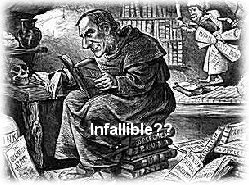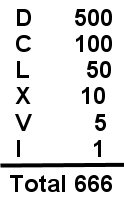Chapter
Thirteen
ARE POPES INFALLIBLE?

ADDING TO THE many contradictions with which the Roman
system was already plagued, there were Popes, like the god Janus
of olden times, who began to claim they were "infallible." People
naturally questioned how infallibility could be linked with the
Papal office when some of the Popes had been very poor examples in
morals and integrity. And if the infallibility be applied only to
doctrines pronounced by the Popes, how was it that some Popes had
disagreed with other Popes? Even a number of the Popes
including Virilinus, Innocent III, Clement IV, Gregory XI, Hadrian
VI, and Paul IV - had rejected the doctrine of Papal
infallibility!
Just how could
all of this be explained in an acceptable manner and formulated
into a dogma? Such was the task of the Vatican Council of
1870. The Council sought to narrow the meaning of infallibility
down to a workable definition, applying such only to Papal
pronouncements made "ex cathedra." The wording finally
adopted was this: "The Roman Pontiff, when he speaks ex cathedra -
that is, when in the exercise of his office as pastor and teacher
of all Christians he defines ... a doctrine of faith or morals to
be held by the whole Church - is, by reason of the Divine
assistance promised to him in blessed Peter, possessed of that
infallibility ... and consequently such definitions of the Roman
Pontiff are irreformable." All of the problems were not
solved by this wording, nevertheless Papal infallibility became an official dogma of
the Roman Catholic Church at the Vatican Council of 1870.
Knowing
the history of the Popes, several Catholic bishops opposed making
Papal infallibility a
dogma at the council. One of these, Bishop Joseph
Strossmayer (1815-1905), is described in "The Catholic
Encyclopedia" as "one of the most notable opponents of Papal
infallibility." He pointed out that some of the Popes had
opposed other Popes. Special mention was made of how Pope Stephen
VI (896-897) brought former Pope Formosus (891-896) to trial.
The
famous story of one Pope bringing another to trial is one of sheer
horror, for Pope Formosus had been dead for eight months!
Nevertheless, the body was brought from the tomb and placed on a
throne. There before a group of bishops and cardinals was
the former Pope, dressed in the rich apparel of the Papacy, a
crown upon his loose scalp, and the scepter of the holy office in
the stiff fingers of his rotting hand!
As the
trial got underway, the stench of the dead body filled the
assembly hall. Pope Stephen stepped forward and did the
questioning. Of course no answers were given to the charges by the
dead man; so he was proven guilty as charged! With this, the
bright robes were ripped from his body, the crown from his skull,
the fingers used in bestowing the Pontifical blessing were hacked
off and his body was thrown into the street. Behind a cart, the
body was dragged through the streets of Rome and finally cast into
the Tiber.
Thus one
Pope condemned another. Then a short time later, The Catholic
Encyclopedia points out, "the second successor of Stephen had the
body of Formosus, which a monk had drawn from the Tiber,
reinterred with full honors in St.Peter's. He furthermore
annulled at a synod the decisions of the court of Stephen VI, and
declared all orders conferred by Formosus valid. John IX
confirmed these acts at two synods ... On the other hand Sergius
111 (904-911) approved in a Roman synod the desicions of Stephen's
synod against Formosus ... Sergius and his party meted out severe
treatment to the bishops consecrated by Formosus, who in turn had
meanwhile conferred orders on many other clerics, a policy which
gave rise to the greatest confusion." Such sharp disagreement
between Popes certainly argues against the idea of papal
infallibility.
Pope
Honorius I, after his death, was denounced as a heretic by the
Sixth Council held in the year 680. Pope Leo II confirmed
his condemnation. If Popes are infallible, how could one condemn another?
Pope
Vigilius, after condemning certain books, removed his
condemnation, afterward condemned them again and then retracted
his condemnation, then condemned them again! Where is
infallibility here?
Dueling
was authorized by Pope Eugene III (1145-53). Later Pope Julius II
(1503-13) and Pope Pius IV (1559-65) forbade it. At one time
in the eleventh century, there were three rival Popes, all of
which were disposed by the council convened by the Emperor Henry
III. Later in the same century Clement III was opposed by Victor
III and afterwards by Urban II. How could Popes be infallible when they opposed
each other?
What is
known as the "great schism" came in 1378 and lasted for fifty
years. Italians elected Urban VI and the French cardinals
chose Clement VII. Popes cursed each other year after year, until
a council disposed both and elected another!
Pope
Sixtus V had a version of the Bible prepared which he declared to
be authentic. Two years later Pope Clement VIII declared
that it was full of errors and ordered another to be made!
Pope
Gregory I repudiated the title of "Universal Bishop" as being
"profane, superstitious, haughty, and invented by the first
apostate." Yet, through the centuries, other Popes have
claimed this title.
Pope
Hadrian II (867-872) declared civil marriages to be valid, but
Pope Pius VII (1800-23) condemned them as invalid.
Pope
Eugene IV (1431-47) condemned Joan of Are to be burned alive as a
witch. Later, another Pope, Benedict IV, in 1919, declared her to
be a "saint."
When we
consider the hundreds of times and ways that Popes have
contradicted each other over the centuries, we can understand how
the idea of Papal infallibility is difficult for many people to
accept. While it is true that most Papal statements are not
made within the narrow limits of the 1870 "ex cathedra"
definition, yet if Popes have erred in so many other ways, how can
we believe they are guaranteed a divine infallibility for a few
moments if and when they should indeed decide to speak ex
cathedra?
Popes
have taken to themselves such titles as "Most Holy Lord", "Chief
of the Church in the World", "Sovereign Pontiff of Bishops", "High
Priest", "the Mouth of Jesus Christ", "Vicar of Christ", and
others. Said Pope Leo XIII on June 20, 1894, "We hold upon the
earth the place of God Almighty." During the Vatican Council of
1870, on January 9, it was proclaimed: "The Pope is Christ in
office, Christ in jurisdiction and power ... we bow down before
thy voice, O Pius, as before the voice of Christ, the God of
truth; in clinging to thee, we cling to Christ. "
But the
historical sketch that we have given plainly shows that the Pope
is NOT "Christ in office" or in any other way. The contrast
is apparent. The very expensive crowns worn by the Popes have cost
millions of dollars. Jesus, during his earthly life, wore no crown
except the crown of thorns. The Pope is waited on by
servants. What a contrast to the lowly Nazarene who came not
to be ministered to, but to minister! The Popes dress in
garments that are very elaborate and costly - patterned after
those of the Roman emperors of sun
worship days. Such vanity is contrasted to our
Savior - Popes - especially in past centuries--stands in striking
contrast to the Christ who is perfect in holiness and purity.
In view
of these things, we believe the claim that the Pope is the "Vicar
of Christ" is without any basis in fact. As early as
the year 1612 it was pointed out, as Andreas Helwig did in his
book "Roman Antichrist," that the title "Vicar of Christ" has a
numerical value of 666. Written as "Vicar of the Son of God"
in Latin, Vicarivs Filii Dei, the letters with numerical value are
these: i equals 1 (used six times), l equals 50, v equals 5, c
equals 100, and D equals 500. When these are all counted up, the
total is 666. This number reminds us, of course, of
Revelation 13:18, "Let him that hath understanding count the
number of the beast: for it is the number of a man; and his number
is six hundred threescore and six."
It
should be pointed out in all fairness, however, that numerous
names and titles, depending on how they are written or which
language is used, can produce this number. The examples
given here will be of special interest because they are linked
with Rome and with Roman Catholicism. According to Hislop,
the original name of Rome was Saturnia, meaning "the city of
Saturn." Saturn was the secret name revealed only to the initiates
of the Chaldean mysteries, which - in Chaldee - was spelled with
four letters: S T U R. In this language, S was 60, T was
400, U was 6, and R was 200, a total of 666.
Nero
Caesar was one of the greatest persecutors of Christians and
emperor of Rome at the height of its power. His name, when
written in Hebrew letters, equals 666.
The
Greek letters of the word "Lateinos" (Latin), the historical
language of Rome in all its official acts, amount to 666. In
Greek, L is 30, a is 1, t is 300, e is 5, i is 10, n is 50, o is
70, and s is 200, a total of 666. This was pointed out by
Irenaeus as early as the third century. This same word also means
"Latin man" and is but the Greek form of the name Romulus, from
which the city of Rome is named. This name in Hebrew,
Romiith, also totals 666.

Unlike
the Greeks and Hebrews, the Romans did not use all letters of
their alphabet for numbers. They used only six letters: D,(500) C,(100) L,(50) X,(10) V,(5) and I,(1). (All other numbers were
made up of combinations of these *). It is interesting and
perhaps significant that the six letters which make up the Roman
numeral system when added together total exactly 666.
Turning
to the Bible itself, in the Old Testament, we read that king
Solomon each year received 666 talents of gold (1 Kings
10:14). This wealth played an important part in leading him
astray. In the New Testament, the letters of the Greek word
"euporia," from which the word WEALTH is translated, total 666.
Out of all the 2,000 Greek nouns of the New Testament, there is
only one other word that has this numerical value, the word
"paradosis," translated TRADITION (Acts 19:25; Matt. 15:2).
Wealth and tradition - interestingly enough - were the two great
corruptors of the Roman Church. Wealth corrupted in practice
and honesty; tradition corrupted in doctrine.



